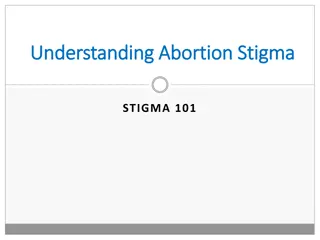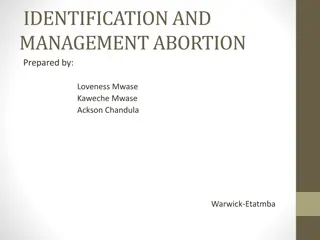Spontaneous Abortion in First Trimester
Causes, types, diagnosis, and management of spontaneous abortion in the first trimester. Learn about DDX of vaginal bleeding, treatment options, and complications. Image sources included.
Download Presentation

Please find below an Image/Link to download the presentation.
The content on the website is provided AS IS for your information and personal use only. It may not be sold, licensed, or shared on other websites without obtaining consent from the author.If you encounter any issues during the download, it is possible that the publisher has removed the file from their server.
You are allowed to download the files provided on this website for personal or commercial use, subject to the condition that they are used lawfully. All files are the property of their respective owners.
The content on the website is provided AS IS for your information and personal use only. It may not be sold, licensed, or shared on other websites without obtaining consent from the author.
E N D
Presentation Transcript
SPONTANEOUS ABORTION Objectives: 1. DDX of 1 st trimester vaginal bleeding. 2. Types, causes, complications, and treatment options of SAB. 433OBGYNteam@gmail.com
Definition : Loss of pregnancy before 20 weeks of gestation. In KSA its loss of pregnancy before 24 weeks of gestation REMEMBER!! DDx for vaginal bleeding : *Spontaneous abortion. *Viable, intrauterine pregnancy. *Ectopic pregnancy. When a female presents with vaginal bleeding in 1st trimester you have to asses the following : Serial of B- HCG values*. Site of pregnancy. Is it viable or not ? Transvaginal ultrasound. *B-HCG should rise 50% in 48 hours ( normally ) , if it is decreasing it means the pregnancy is not viable and you should thing of either ( Spontaneous abortion , ectopic pregnancy )
Transvaginal ultrasound evaluation timeline : Gestational sac (4.5-5 weeks of EGA ) Types of spontaneous abortion : Cervix open Cervix closed Yolk sac ( 5-6 weeks) Fetal pole with cardiac activity ( 5.5-6 weeks ) Products passed Incomplete abortion Complete abortion Products not passed Inevitable abortion Missed abortion 1 st Trimester The most common cause of SAB is chromosomal abnormalities. Which increases with the increasing maternal age . 2 nd Trimester Mostly caused by maternal systemic disease, abnormal placentation, or other anatomic considerations.
Type Definition Diagnosis Management Pregnancy is complicated by vaginal bleeding before 20 WKS in absences of other explanations. - - - - Mild bleeding. Mild pain. Cervix is closed. U\S + bimanual all fine. - - - - Reassurance Rest Progestrone Anti-D if Rh- Threatened abortion Pregnancy is complicated by both vaginal bleeding and cramp-like lower abdominal pain - - - - Heavy bleeding with clots. Severe pain. Cervix is open. Products are felt in cervical canal. No passage of tissue. - - - - - - IV fluid. Cross match blood. Oxyctocin Syntocinon IV infusion Evacuation of the uterus. Anti-D if Rh- Inevitable abortion - In addition to vaginal bleeding, cramp-like pain, and cervical dilation. - Partial explosion of products. (like pieces of skin or liver) Open cervix. U\S: retained products of conception. SAME as above. Incomplete abortion Once the patient is stable the remaining products of conception evacuated under appropriate pain management. - - Passage of all products of conception. - - - - Heavy bleeding + clots. Severe pain. Passage of tissue. Stoppage of pain and bleeding. Cervix is closed. Uterus is smaller than the gestational age. Pregnancy symptoms abate. Pregnancy test becomes - Complete abortion - - - -
Types Missed abortion Definition Diagnosis Managment When the fetus has died but is retained in the uterus, usually for more than 6 wks. - Gradual disappearance of pregnancy signs and symptoms. Brownish discharge. Pregnancy test may remain + for 3-4 wks. U\S: no fetal heart beat, empty sac. Can be complicated by septic abortion and DIC so better to be evacuated surgically to minimize the risks. - - - Uterine infection at any stage of pregnancy. Caused by: delay evacuation, incomplete surgical evacuation followed by vaginal organisims after 48 hours - Fevers, chills. - Lower abdominal discomfort - foul vaginal discharge. - Oral board spectrum antibiotics. Septic abortion 3 consecutive miscarriages, but many clinicians feel that 2 successive 1 st trimester losses or a single 2 nd trimester spontaneous abortions is justification for an evaluation of a couple for the causes of pregnancy losses. - - Rule out systemic diseases. Paternal and maternal chromosomes. Hysteroscopy or historiography. Rule out infectious diseases. Pelvic U\S to rule out any congenital anomalies of the uterus. Recurrent abortion - - -
Causes of spontaneous abortion Fetal Causes Maternal Causes 50% of SAB in the 1 ts trimester are due to chromosomal anomalies. (mostly trisomy's, also can be monosomy and trioloids) Environmental Immunological Autoimmune diseases, Alloimmune response Endocrine Hypo\hyper-thiroid, DM, luteal phase defect Alcohol, smoking drug abuse, radiation Uterine abnormality Congenital, Fibroid, Cervical impotence Infections TROCH T: Toxoplasma R: Rubella O: Others, (syphillis,paro B19) C: Cytomegalovirus H: Herpes
Treatmentoptions Expectant management REMEMBER!! If the patient is Rh- she will need Rhogam injection to protect against isoimmunaization in future pregnancy. Medical management ( vaginal misoprostol ) Surgical evacuation (D&C or MVA) Complications of spontaneous abortion Septic abortion Hemorrhage Endometritis If heavy vaginal bleeding with retained products of conception > Surgical evacuation. Should be treated with oral broad spectrum antibiotics. Signs and symptoms are fevers, chills, lower abdominal discomfort, and foul vaginal discharge.
Teaching case A 32 year-old G1 woman presents with a positive urine pregnancy test at 9 weeks 4 days from start of last normal menstrual period. She reports 5 days of moderate painless vaginal bleeding and chills. Physical examination shows a temperature of 101.5 orally, pulse 95, and BP 95/60 with normal bowel sounds, no rebound, and 5/10 suprapubic tenderness. Pelvic exam shows moderate amount of blood in vagina with a closed 5/10 tender cervix and an 8/10 tender uterus. No adnexal masses or tenderness. Lab data shows a serum - -hCG level of 6,500 mIU/ml and ultrasound shows a gestational sac in the uterus with no fetus seen. The ovaries and tubes appear normal.
Question Answer 1 What are the different types of spontaneous abortion? Threatened abortion Incomplete abortion Inevitable abortion Complete abortion Missed abortion (subtype is blighted ovum) Septic abortion Recurrent abortion 2 Which type or types is most likely in this case and why? Septic abortion Fever Tenderness Hypotension Tachycardia 3 Why does this patient have a fever and tenderness and what needs to be done about it? The fever originates from infected non-viable products of conception. The patient needs immediate evacuation of the uterus and antibiotics in order to prevent worsening infection, sepsis and possible septic Shock.
4 If this patient was 6 weeks pregnant with no fever or tenderness, had an -hCG level of 700 mIU/ml and a negativeultrasound with no evidence of a gestational sac, what would be your differential diagnosis if she had a small amount of bleeding and no fever or tenderness? The first diagnosis to exclude would be ectopic pregnancy. A closed cervical os could indicate either a threatened abortion with a gestation which was so early that it could not be visualized on ultrasound or completed abortion in which the products of conception have already passed though this is less likely given the small amount of bleeding she has had. A missed abortion occurs when the patient is asymptomatic but has a non-viable pregnancy, as diagnosed by falling -hCG levels or ultrasound imaging. 5 How would you make the diagnosis in question 4? If no intrauterine gestational sac can be seen on ultrasound, order serial beta -hCG s since the initial - HCG level is too low for ultrasound to show an intrauterine pregnancy (IUP) (which usually is seen on vaginal ultrasound at 1500-2000 mIU/ml - hCG). If this is a viable intrauterine pregnancy, the -hCG level usually will increase at least 66% when repeated in 48 hours. If it does not, then a viable intrauterine pregnancy is unlikely. If the patient is stable, repeated quantitative -hCG levels can be performed and followed until negative. Diagnostic D&C can be performed as well once viable IUP has been ruled out. Once a diagnosis of ectopic or abnormal intrauterine pregnancy is confirmed, appropriate treatments can be implemented.
6 For a patient with any type of abortion, what blood test is essential to do? Blood typing for Rh factor is essential followed by RHoGAM injection if patient is Rh negative. This is vital to prevent Rh sensitization in a subsequent pregnancy. 7 What are the causes of spontaneous abortion? Possible causes include infection, fetal chromosomal abnormality, uterine malformation, immunologic dysfunction, diabetes, thyroid disease, subclinical infection, trauma, as well as teratogenic or environmental Exposures. 8 What are treatment options for spontaneous abortion? For incomplete, inevitable and missed abortions, management may include expectant, medical or surgical management. Surgical management with dilation and curettage or manual vacuum aspiration is more definitive. Medical management with prostaglandins, or expectant management, may be associated with bleeding and still require surgical evacuation.
Done by : Amani Alotaibi Rawan Alotaibi Revised by: Razan AlDhahri























